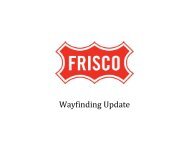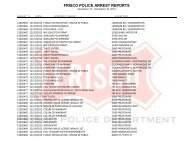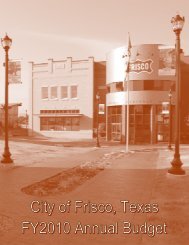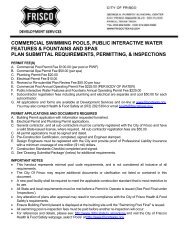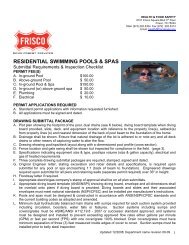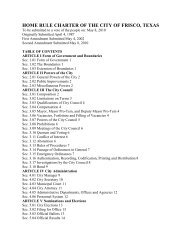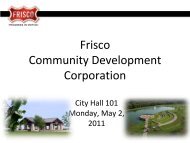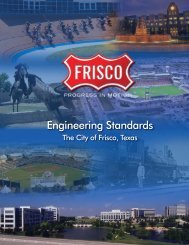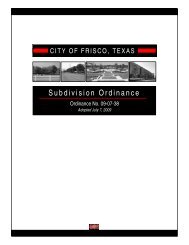Modern Roundabout Feasibility Study - City of Frisco
Modern Roundabout Feasibility Study - City of Frisco
Modern Roundabout Feasibility Study - City of Frisco
You also want an ePaper? Increase the reach of your titles
YUMPU automatically turns print PDFs into web optimized ePapers that Google loves.
OHIO DRIVE ROUNDABOUT FEASIBILITY STUDY, CITY OF FRISCO<br />
7.0 TRAFFIC CONTROL PLAN FOR CONSTRUCTION<br />
It is anticipated that the proposed roundabouts at Gaylord Parkway and Warren Parkway can be<br />
built while maintaining one lane <strong>of</strong> traffic open in each direction. On the other hand, the<br />
proposed roundabout at Prestmont Place may require a temporary closure <strong>of</strong> the intersection. A<br />
conceptual plan for traffic control during construction is provided below for each intersection.<br />
7.1 Ohio Drive at Gaylord Parkway<br />
This proposed roundabout will utilize the existing concrete pavement and only minimal amounts<br />
<strong>of</strong> new pavement will be constructed. It will be possible to maintain the intersection open to<br />
traffic while the roundabout construction is ongoing. The basic construction sequence is as<br />
follows:<br />
Phase I<br />
1. Close the east leg <strong>of</strong> Gaylord Parkway temporarily. Currently, this leg only carries<br />
approximately 540 vehicles per day and is back access to the Chevrolet dealership. It<br />
is estimated that the east leg <strong>of</strong> Gaylord Parkway would be closed for two months.<br />
2. Maintain one lane <strong>of</strong> traffic open in each direction on the west side <strong>of</strong> Ohio Drive (on<br />
the existing southbound lanes pavement), and one lane <strong>of</strong> traffic open in each<br />
direction on the north side <strong>of</strong> Gaylord Parkway, as illustrated in Figure 18.<br />
3. Build the east half <strong>of</strong> the proposed roundabout, except for the center island and truck<br />
apron.<br />
Phase II<br />
1. Move traffic to the completed lanes on the east side <strong>of</strong> Ohio Drive and the north side<br />
<strong>of</strong> Gaylord Parkway, as illustrated in Figure 19.<br />
2. Build the remaining approaches and islands on the west side <strong>of</strong> Ohio Drive and the<br />
south side <strong>of</strong> Gaylord Parkway, except for the center island and truck apron.<br />
7.2 Ohio Drive at Warren Parkway<br />
This proposed roundabout will utilize the existing concrete pavement and only minimal amounts<br />
<strong>of</strong> new pavement will be constructed. It will be possible to maintain the intersection open to<br />
traffic while the roundabout construction is ongoing. The basic construction sequence is the<br />
same as the construction sequence for the roundabout at Gaylord Parkway as explained in<br />
Section 7.1. Therefore, the east leg <strong>of</strong> Warren Parkway will also be closed temporarily. Access<br />
to and from properties along Warren Parkway (east <strong>of</strong> Ohio Drive) will be maintained by detour<br />
routes via Hillcrest Road, Lebanon Road, or Prestmont Place.<br />
7.3 Ohio Drive at Prestmont Place<br />
Due to the proposed geometry <strong>of</strong> the roundabout which is shifted to the west, it will be desirable<br />
to construct new pavement for this roundabout. Maintaining two-way traffic during construction<br />
would be very difficult and expensive, since it would require the construction <strong>of</strong> temporary<br />
pavements. Therefore, two other alternatives were considered as follows:<br />
Alternative 1 - Close the intersection for construction during a summer month and accelerate<br />
construction to take the minimum possible time. It is estimated that the roundabout can be built<br />
in approximately one month in this situation. Detour signing would have to be provided for both<br />
pass-through traffic and local traffic. For pass-through traffic, detour signing would be placed on<br />
the adjacent major thoroughfares to re-route through-traffic around the intersection. For local<br />
traffic, local detour signing would re-route traffic to the adjacent streets.<br />
Alternative 2 - Reduce the number <strong>of</strong> lanes to a single lane in only one direction, to maintain<br />
one-way traffic. This would allow constructing the roundabout in two halves. Detour local<br />
traffic in the other direction, and detour pass-through traffic around the intersection. While this<br />
alternative would maintain some traffic through the intersection, it would take longer for the<br />
roundabout construction. It would also cost more and require extensive traffic control during<br />
construction.<br />
Alternative 1 would be the more desirable choice since there are other existing streets that can be<br />
used as alternate routes to access the properties in the vicinity <strong>of</strong> the intersection.<br />
Phase III<br />
1. Open the roundabout to traffic but as a single lane roundabout, with one lane open in<br />
each direction, as illustrated in Figure 20.<br />
2. Construct the center island and truck apron.<br />
3. If the asphalt overlay option is selected, place the final pavement overlay.<br />
4. Install final signing and pavement markings.<br />
BROWN & GAY ENGINEERS, INC.<br />
20



